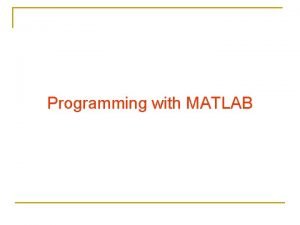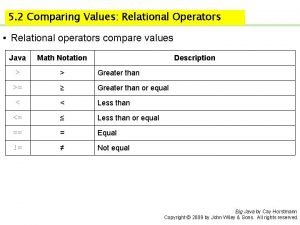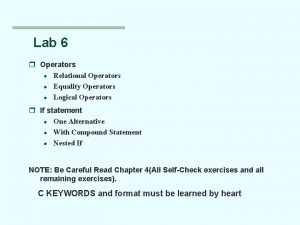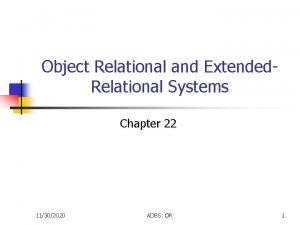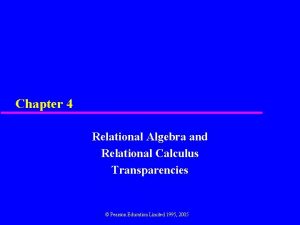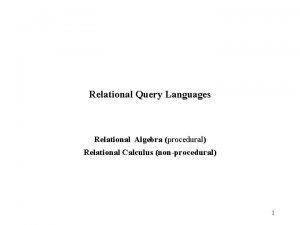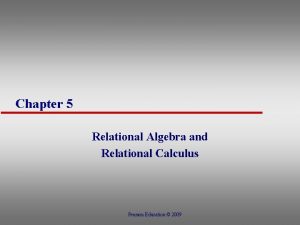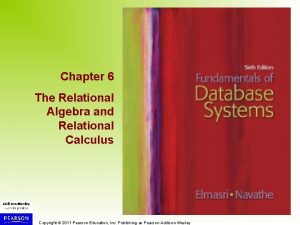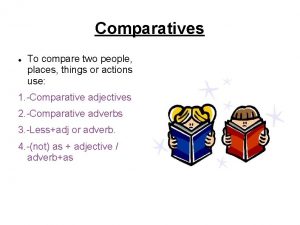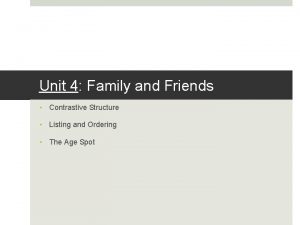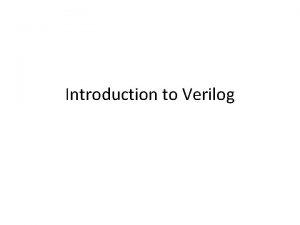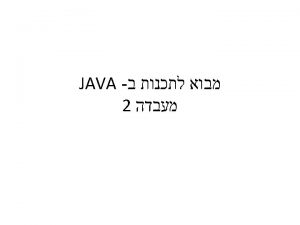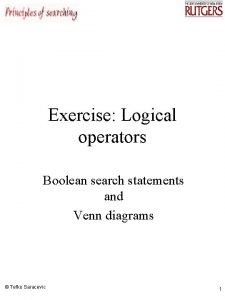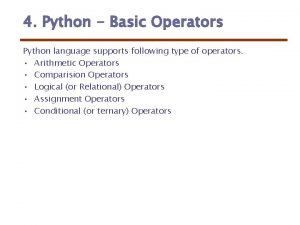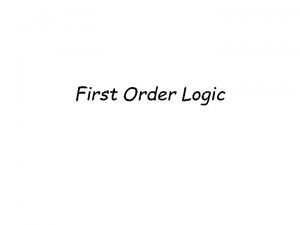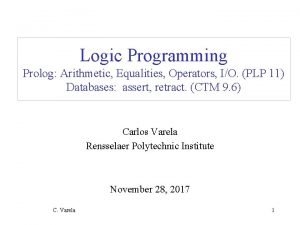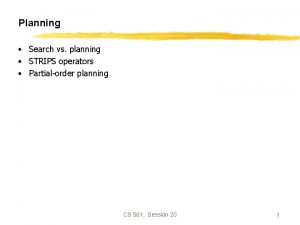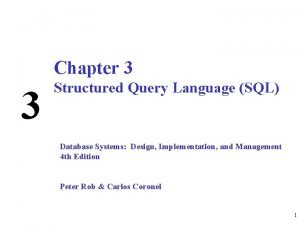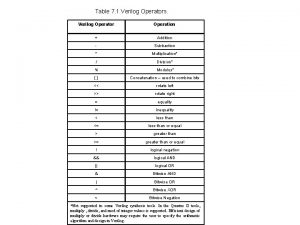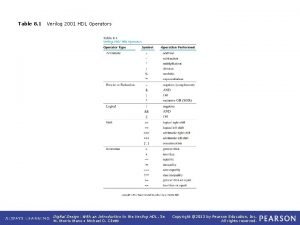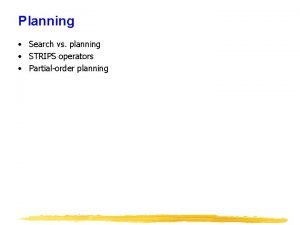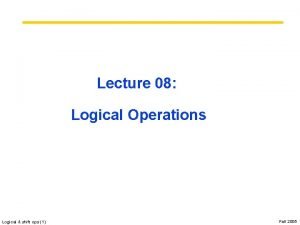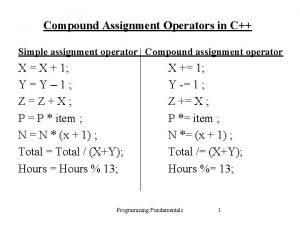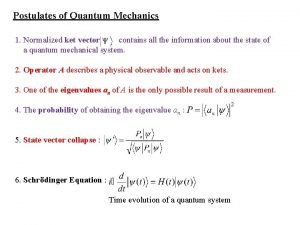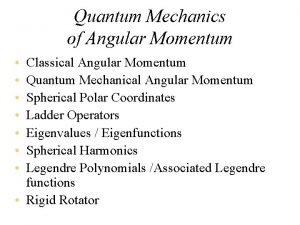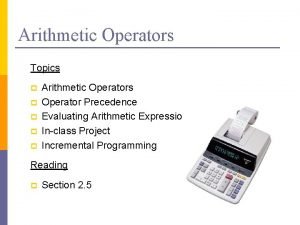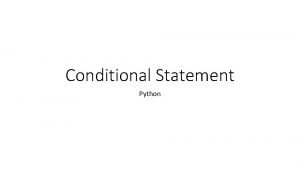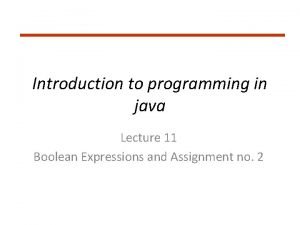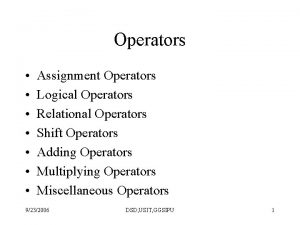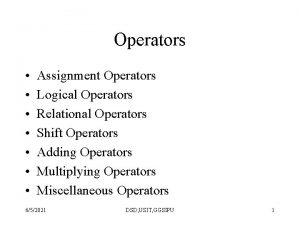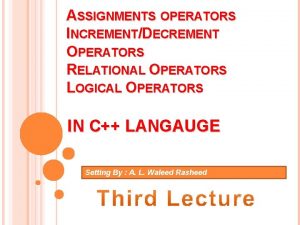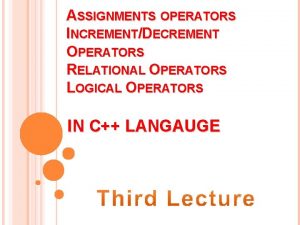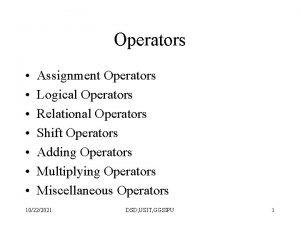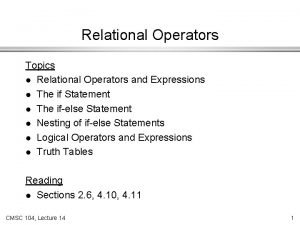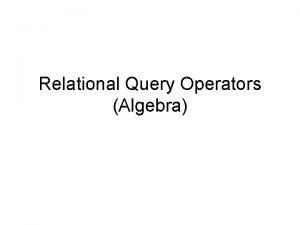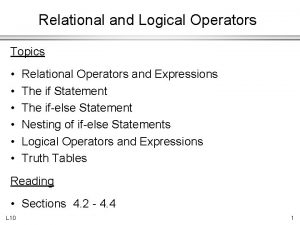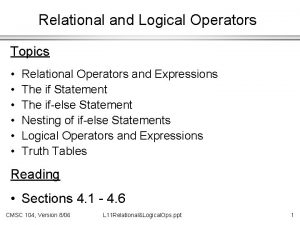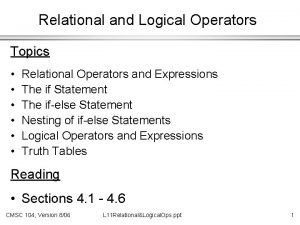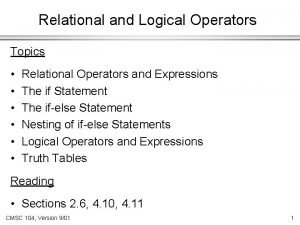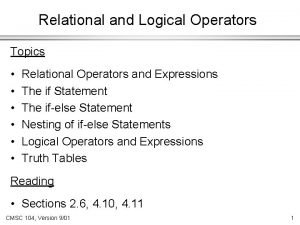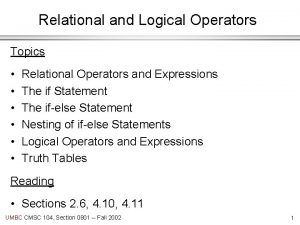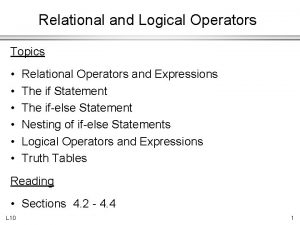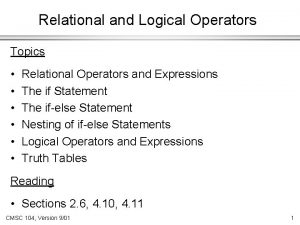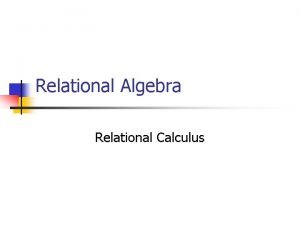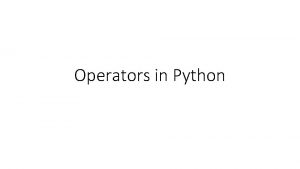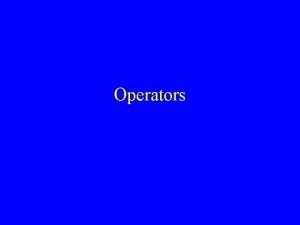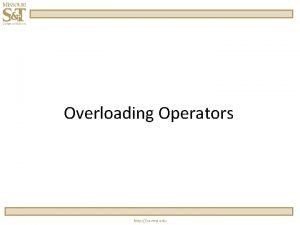Relational Operators Relational operators are used to compare













































- Slides: 45

Relational Operators • Relational operators are used to compare two numeric values and create a boolean result. – The result is dependent upon the relationship between the two operators. – Relational operators are evaluated after all arithmetic operators.

Relational Operators

Relational Operators 4>6 7 + 3 / 2 == 5 + 5 / 2 Assume a = 4 and x = 9, a <= b

Logical Operators • Logical Operators are used to compare boolean values and create a boolean result. – Logical operators are usually used to compare the results of relational operators. – Logical operators are evaluated after all relational operators. – Logical operators are && (logical And), & (boolean And), || (logical Or), | (boolean Or), ^ (boolean Exclusive Or), and ! (logical Not).

Logical Operators • && (logical And): Expression 1 True False Expression 2 True False Expression 1 && Expression 2 True False

Logical Operators • II (logical Or): Expression 1 True False Expression 2 True False Expression 1 || Expression 2 True False

Logical Operators • && vs. & and || vs. | – Both && and || will only evaluate the expressions until it knows a result while the & and | operators will evaluate all the expressions before they return the result. – Gender == 1 || age >= 65 – Gender == 1 | age >= 65

Logical Operators • ^ (logical Exclusive Or): Expression 1 True False Expression 2 True False Expression 1 ^ Expression 2 False True False

Logical Operators • ! (logical Not): Expression 1 True False ! Expression 1 False True

Logical Operators • (4 >= 7) && (3 + 4 == 7) || (4 < 7) && true

Control Structures • Control structures are used to organize actions (statements). • Examples: – Sequence Structure – Selection Structure – Repetition Structure

Main. Window main. Window = new Main. Window(); Output. Box output. Box = new Output. Box( mainwindow); output. Box. print. Line(“ Welcome to”); output. Box. print. Line( “Java Programming!”); Sequence Structures public static void main(String[] args) { Main. Window main. Window = new Main. Window; Output. Box output. Box = new Output. Box(main. Window); output. Box. print. Line( “Welcome to”); output. Box. print. Line( "Java Programming!”); }

Selection Structures • Selection Structures allow you to write code that will select and execute specific code statements instead of other code statements.

If Selection Structure • The basic structure of an if statement in Java is: if (boolean_expression) { statement; }

If Selection Structure • If the boolean_expression is true then the statement is executed. • If the boolean_expression is false then the statement is skipped and the next statement in the sequence is executed.

If Selection Structure hungry == true False True output. Box. print. Line (“find some food”); If (hungry == true) { output. Box. print. Line(“find some food”); }

If Selection Structure • Let’s create the statements for the following problem: We want to categorize grades such that we will print out the corresponding letter grade. Assume <60 = F, 60 – 69 = D, 70 - 79 = C, 80 - 89 = B, and >90 = A.

If/else Selection Structure • The if/else statement allows you to write code that executes one statement if the boolean_expression is true and different statement if the boolean_expression is false.

If/else Selection Structure • The basic structure of an if/else statement in Java is: if (boolean_expression) } statement 1; } else { statement 2; }

If/else Selection Structure If (hungry == true) { output. Box. print. Line(“find some food”); } else { output. Box. print. Line(“get more work done”); } output. Box. print. Line( “get more work done); False Hungry == true True output. Box. print. Line(“ find some food”);

If/else Selection Structure • The statement inside an if/else structure may be another if/else statement. In Java it looks like: if (boolean_expression_1) { statement 1; } else { if (boolean_expression_2) { statement 2; } else { statement 3; } }

If/else Selection Structure • It may also be written as: if (boolean_expression_1) { statement 1; } else if (boolean_expression_2) { statement 2; } else { statement 3; }

If/else Selection Structure • Let’s look at our grade program again and rewrite it using the if/else structure.

If/else Selection Structure • The if/else and if statements we have worked with so far execute only one statement. We can also execute multiple statements using compound statements. – Compound statements are actually multiple statements enclosed in brackets { }

If/else Selection Structures • The format for an if/else statement which includes a compound statement in Java is: if (boolean_expression) { statement 1; statement 2; } else { statement 3; statement 4; statement 5; statement 6; }

Nesting If Statements • Nesting if statements makes your program more powerful because it can handle many different situations. – Nesting occurs when one or more if structures are inside of another if statement. – The else statement is always associated with the previous if statement unless { } are used to change the associativity. • Dangling else

Nested If Statements • What is printed when the following is evaluated: if (y == 8) if (x == 5) output. Box. print. Line(“ 1”); else output. Box. print. Line(“ 2”); output. Box. print. Line(“ 3”); output. Box. print. Line(“ 4”);

The Conditional Operator • The conditional operator is basically a short cut to the if/else structure. – It is called a ternary operator because it has three arguments that form the conditional expression. (boolean_expression? true_operation : false_operation)

The Conditional Operator If (grade > 70) { output. Box. print. Line (“C”); } else { output. Box. print. Line(“F”); } output. Box. print. Line(grade > 70 ? “C” : “F”);

The Conditional Operator Write the conditional operator for the following if/else statement. boolean a = true, b = false, c = true; if ((a && c) && c || b) { output. Box. print. Line(“true”); } else { output. Box. print. Line(“false”); }

The Conditional Operator Write the conditional operator for the following if/else statement. If (grade >= 90) { output. Box. print. Line(“The grade is an A”); } else if (grade >= 80) { output. Box. print. Line(“The grade is an B”); } else if (grade >= 70) { output. Box. print. Line(“The grade is an C”); } else { output. Box. print. Line(“The grade is an F”); }

Switch Selection Structure • The Switch selection structure is basically short hand for multiple if/else statements. It allows you to perform statements for a specific value of a variable when there are multiple possibilities. – The switch expression must be an integer or char result.

Switch Selection Structure switch (switch_expr) { case item_1: statement 1; statement 2; … break; case item_2: statement 1; … break; default: statement 1; … break; }

Switch Selection Structure Case A’ True ++a. Count break ++b. Count break output. Box. print. Line. . . break False Case B’ False . . . default False True switch ( grade ) { case 'A': ++a. Count; break; case 'B': ++b. Count; break; . . . default: output. Box. print. Line( "Incorrect grade. Enter new grade. " ); break; }

Switch Selection Structure • The switch should always use the break statement for each case or the structure will not work properly. • Your switch statements should always have a default case for completeness purposes. • Anything you can represent with a switch you can represent as a nested if/else statement.

Switch Selection Structure Write a program to determine the cost of products sold in the last week at a mail order house. They have five products whose retail prices are: product 1 - $2. 98; product 2 - $4. 50; Product 3 - $9. 98; Product 4 - $4. 49; Product 5 - $6. 87 The program should ask the user to enter the product number and the quantity sold for one day. The program should use a switch statement to determine the total retail price for each product.

Switch Selection Structure • What if you have multiple values you want to test for and have them execute the same “case”?

Switch Selection Structure switch (switch_expr) { case item_1: item_2: statement 1; statement 2; … break; case item_3: statement 1; … break; default: statement 1; … break; }

Switch Selection Structure • Write a program to read in letter grades and calculate how many of each letter are entered.

List. Box Class • A List. Box allows a program to present multiple alternative inputs to the user in a well-defined manner. – A List. Box must be associated with a Main. Window main. Window = new Main. Window(); List. Box list. Box = new List. Box(main. Window);

List. Box Class • When a List. Box is created it has nothing in it. The program must add items to the list. Box. add. Item(“Item One”); – As many items as needed can be added to the list.

List. Box Class • To retrieve the user’s input use the get. Selected. Index() method. int selection = list. Box. get. Selected. Index(); – The first item in the list has an index of zero (0). – If the user makes no selection, then the result is List. Box. NO_SELECTION. – If the user cancels the input, then the result is List. Box. CANCEL.

Color Class • Java represents colors using individual red, green, and blue components combined to create a color. – Each component is a value between 0 and 255. • Black = (0, 0, 0) • White = (255, 255)

Color Class • The color class also provides some predefined colors. (see page 276) – To use the predefined colors you reference them by their name: • Color. magenta – To change the color of an object: object. Name. set. Color(Color. pink);

Drawing. Board Class • The Drawing. Board class can be used to draw shapes. – To draw a line: object. Name. draw. Line( x 1, y 1, x 2, y 2); – To draw a circle: object. Name. draw. Circle(center. X, center. Y, radius); – To draw a rectangle: object. Name. draw. Rectangle(x, y, width, height);
 Mikael ferm
Mikael ferm Relational operators matlab
Relational operators matlab Transition diagram for relational operator
Transition diagram for relational operator Relational operators java
Relational operators java Transition diagram of relational operator
Transition diagram of relational operator Relational operators
Relational operators Relational operators in r
Relational operators in r Object relational and extended relational databases
Object relational and extended relational databases Relational algebra and relational calculus
Relational algebra and relational calculus Relational query language
Relational query language Relational algebra to tuple relational calculus
Relational algebra to tuple relational calculus Relational algebra and relational calculus
Relational algebra and relational calculus Compare two places
Compare two places Contrastive structure is used to compare two things
Contrastive structure is used to compare two things In a premix burner used in fes the fuel used is
In a premix burner used in fes the fuel used is In a premix burner used in fes the fuel used is
In a premix burner used in fes the fuel used is Verilog data types
Verilog data types Mainstring
Mainstring And or truth table
And or truth table Boolean venn diagram
Boolean venn diagram Active high and active low
Active high and active low Shabana ka matlab
Shabana ka matlab Unary python
Unary python Logical operators in r
Logical operators in r Prolog and or operators
Prolog and or operators Morphological operators
Morphological operators Strips operators
Strips operators A structured query language – sql operators are
A structured query language – sql operators are Verilog operators
Verilog operators Verilog operators table
Verilog operators table Operators for advanced internet legal research
Operators for advanced internet legal research Strips operators
Strips operators Logical operators
Logical operators Simple assignment operators
Simple assignment operators What are operators
What are operators Logical operators in boolean algebra
Logical operators in boolean algebra Wireshark operators
Wireshark operators Bagaimana tabel kebenaran operator logika or
Bagaimana tabel kebenaran operator logika or Google search operands
Google search operands Normalized ket
Normalized ket Logical operators priority in c
Logical operators priority in c Miscellaneous operators in javascript
Miscellaneous operators in javascript Angular momentum operators
Angular momentum operators Precedence of operators in python
Precedence of operators in python Operators in python
Operators in python Boolean algebra java
Boolean algebra java

